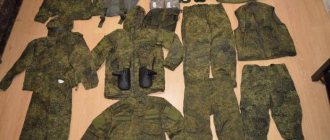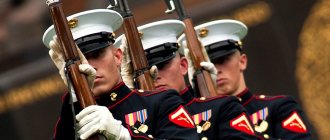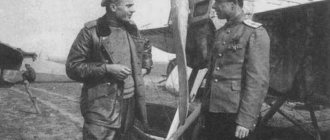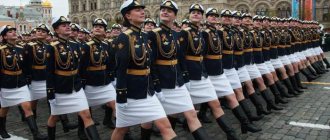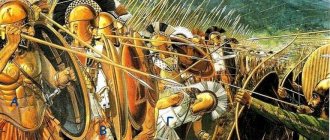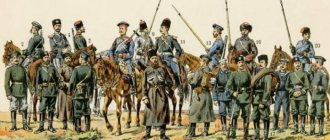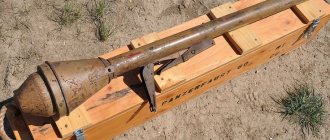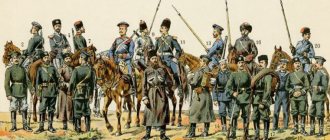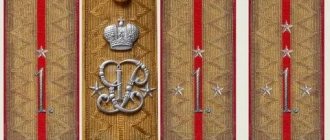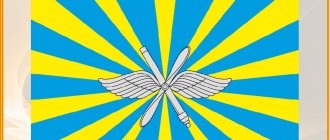The German word “Wehrmacht” (“Wehrmacht”) originally meant the army of the state, however, in Nazi Germany this was the official name of the Armed Forces of the Third Reich. When creating the Wehrmacht as a state army, much attention was paid to the uniform of soldiers, officers and generals of the resurgent German army.
Defeated and humiliated after the 1st World War, Germany, which experienced a terrible crisis with hyperinflation, when salaries were paid every day and were immediately given a break so that workers could spend it, because... by the evening it would have already depreciated; it could slowly begin to recover only after the conclusion of the Rapallo Agreement (aka the pajama agreement) between the German Republic and the Soviet Union in 1922. For both countries, this treaty was a breakthrough: for the USSR it was the first international treaty of a new state, and for Germany it was the first equal treaty after Versailles.
A short period of military-technical cooperation between Germany and the USSR began, which was soon brought to naught after Hitler came to power.
In 1935, the Third Reich adopted the “Law on the Construction of the Wehrmacht.” From that moment on, the provisions of the Versailles Treaty were officially rejected, and the army began preparing for a revanchist war.
However, in addition to the army, there were many auxiliary units in Germany, such as the Waffen-SS (from German Schutzstaffeln - “security units”), the Todt organization (“Organization Todt”) and others.
History of Wehrmacht and SS uniforms
Until 1936, Wehrmacht soldiers and officers also wore the uniform of the Reichswehr (German army during the First World War) with the national emblem (Hoheitszeichen) sewn onto the chest - the eagle with a swastika, well-known from the films. Only in 1936 did the transition to a new form officially take place.
The basis of the uniform was the military uniform (Waffen Rock) of the 1936 model. It was a tunic with five buttons and patch pockets in the color “Feldgrau” (field gray) with piping in the color of the military branch along the side and collar:
- carmine red color - War Ministry and Veterinary Service;
- crimson color - General Staff;
- white - infantry;
- grass-green color - motorized infantry (panzergrenadiers);
- light green color - mountain infantry, rangers;
- pink color - tank troops and anti-tank artillery (for combined arms uniforms);
- red - artillery;
- burgundy color - chemical defense parts and rocket artillery parts;
- black color - engineering troops;
- golden yellow color - cavalry and reconnaissance;
- copper-yellow color - motorized reconnaissance;
- lemon yellow color - signal troops;
- orange color - field gendarmerie and personnel replenishment bodies (military registration and enlistment offices);
- grayish-blue color - vehicle parts;
- cornflower blue - medical service,
- purple - priests of the Catholic and Lutheran churches.
As can be seen from the list, it was not difficult to get confused in such diversity. In the memoirs of one of the tank crews there is an episode when he captured one of the Wehrmacht generals, but he was not given an order, but only a medal “For Courage.” However, from the description it is clear that he captured a senior officer of the OKW General Staff (from Hauptmann to Oberst), and the reason for the confusion was that the General Staff officers wore general stripes on their uniform trousers. Moreover, an officer of the general staff did not mean at all that this was an officer from the main headquarters of the troops, but simply that this person served at the headquarters. And the headquarters can be at both the regiment and the division.
Jacket model 1936
However, Nazi Germany did not only have an army. The SS organization stands out separately (Schutzstaffeln - “security squads”). Initially formed as part of the assault troops (SA, Brown Shirts, NSDAP combat units), the SS quickly became a separate structure.
After the “night of long knives,” which ended with the destruction of the top of the SA and the separation of the SS into a separate structure, the SS became the main striking force of the ruling party and began the formation of combat units. In 1940, these units received the name SS Troops (die Waffen-SS). Also in service remained the general SS (Allgemeine SS), which did not take part in hostilities, but were used on the territory of the Third Reich. Service in the general SS was not considered military service.
In 1930, SS personnel received the infamous black uniform with runes. Only verified true Aryans could wear runes in their buttonholes. Other national units of the SS troops did not have the right to wear them. Instead of runic signs, national buttonholes or unit buttonholes were used.
Later, a ceremonial white uniform and a feldgrau uniform for field conditions were introduced.
The highest ranks of the Wehrmacht and SS, as well as those awarded the Knight's Cross, had the right not to fasten the top buttons of their overcoat so that their rank awards were visible.
It is also impossible not to mention Todt's form of organization. After the Anschluss of Czechoslovakia, the uniform of its army was used to outfit the organization's units. The trophy uniform was very different from the army one, even the color was olive, and not “field gray”.
Buttonholes of Todt units
The most famous uniform of the elite Die Waffen-SS unit
Dress uniform of Die Waffen-SS officers
Die Waffen-SS field uniform
Uniform jacket model 1943
The austerity regime imposed on the German industry producing military uniforms by the protracted war after 1942, and the ever-increasing shortage of material, forced changes to be made in the cut of standard general-arms uniforms, designed to reduce material consumption and the amount of skilled labor required for its production.
The uniform jacket of the 1943 model and, to an even greater extent, the field jacket of the 1944 model largely met precisely these two requirements. The model of the 1943 uniform jacket demonstrates for the first time since its introduction in 1936 the absence of the dark blue-green cloth that covered the collar. shoulder straps appear , which at first were worn only with a jacket, and then began to be worn with any uniform. The four patch pockets of the jacket are made without central folds, the pocket flaps are slightly reduced, and they are no longer curly, but straight. Otherwise, this jacket was no different from the earlier uniform jacket of the 1936 model.
Until 1935, the uniforms of the German army were made from pure wool, but since 1935 they began to be made from fabric with the addition of 5% viscose fiber. Then its content was increased to 20%, and during the war it reached 65%. wool , regenerated wool (shoddy) and wool waste were used to make uniform fabric By 1943, about 90% of uniform fabric was made from shoddy and wool waste; the latter were often a natural gray color and did not require additional coloring.
The wool content of the 1943 uniform was greatly reduced, while the viscose content increased proportionately. This already lowered the quality of the fabric, but, in addition, even the wool was increasingly recycled and of poor quality, so even the new jacket of the 1943 model looked like it was worn. It did not hold heat well and quickly got wet in wet weather.
| The 1941 model uniform had 6 buttons. The cut and style of the uniform remained unchanged, only the quality of the fabric used deteriorated. | On the 1942 model uniform, the folds on the pocket were eliminated and the flap was less curved. That same year, the canvas belt to support the waist belt will be permanently eliminated. Hooks for the waist belt were attached to the inside of the uniform with fabric pads. The pictures show detail of the hook and loop collar and waist belt hooks. | ||
| The last example of a uniform was the 1943 model, which featured straight pocket flaps. The linings were made of artificial silk. The photo shows a sergeant major's field jacket with shoulder straps made of dark blue-green cloth and a braid on the collar made of aluminum threads. | |||
| Freshly minted Knight of the Iron Cross 2nd class, corporal . His shoulder strap , attached to a loop, is upside down. This form of concealed carry was used by individual non-commissioned officers at the beginning of the war, during the Polish and French campaigns. To hide the insignia on the shoulder straps, they simply turned them over. Since there are no special distinctive marks on the inside of the shoulder straps, the enemy could not obtain any information about the units of the German army operating against him by looking at the shoulder straps through binoculars . | |||
What is special about the Wehrmacht uniform?
The uniform of the German army at the beginning of World War II compared favorably with the uniform of other belligerent armies. In the Wehrmacht, they were the first to indicate belonging to a participating country (eagle), the types of troops were clearly designated, and there was no confusion with the ranks of officers for the soldiers of their army.
However, frosty Russia quickly revealed the shortcomings of the uniform: there are cold overcoats, especially when the Red Army en masse changed into quilted jackets. That is why it was so often possible to see captured Germans dressed haphazardly in the winter. In the summer, it was terribly hot in field jackets, which forced the soldiers to unbutton and roll up their sleeves. This fact received a lot of attention in Soviet cinema.
But the author cannot fail to mention the following fact. The color, appearance and shape of the Wehrmacht is very well ingrained in the genes of the Russian people. The author somehow accidentally saw people in the uniform of Hitler’s army, and although he had never seen such a uniform in person in his life, there was a very clear message from the subconscious that he had to go and kill them. Due to the lack of a machine gun at hand, the author approached the people in the feldgrau almost unarmed and found out that they were actors from the film set. Therefore, the heart let go of hatred, and everyone remained unharmed.
Wehrmacht uniform
Special differences between the SS form and other German forms
The SS were probably the first to introduce so-called camouflage patterns. Moreover, the Flektarn pattern introduced by the SS units is still used by the Bundeswehr. This type of used camouflage is supplied all over the world: in both Russia and Ukraine you can see people wearing camouflage of this color. To be fair, it should be noted that the modern name “Flektarn” was introduced in the 1970s. The camouflage was originally called "Platanenmunster".
Reversible camouflage jacket in platanenmuster autumn side out
The camouflage uniform was double-sided - spring-summer and autumn-winter colors. Summer colors were green, winter colors were closer to variations of orange. Badges indicating rank were sewn onto the uniform. The color of the stripes is green.
At first, the SS cockade was considered the “Death’s Head” (der Totenkopf), however, after the formation of detachments, and later divisions with this name, the cockade was changed to the imperial image of an eagle.
Untersturmführer (lieutenant) of the SS troops in a camouflage jacket in platanenmuster colors with the summer side facing out
SS-Beringt-Eichenlaubmuster
Summer side of Beringt-Eichenlaubmuster
“Round oak leaves” is a variant of the “oak” camouflage with rounded spots. It's possible. that this option is the earliest version of the “oak leaves” camouflage. Researchers date the beginning of the production of camouflage of this pattern to 1942. In black-and-white wartime photographs, it is almost impossible to distinguish “cool oak leaves” from simply “oak leaves.” The fabric of the Beringt-Eichenlaubmuster pattern was used to make covers for helmets, jackets, caps and capes, and possibly for overalls . The differences between Beringt-Eichenlaubmuster and Eichenlaubmuster are most noticeable in the Wintertarnanzug winter parks. camouflage was applied to winter parkas .
Wehrmacht women's uniform
After the outbreak of hostilities in the European TBD (theater of combat), there was a need to expand support units and personnel. These positions were well suited to be filled by female military personnel. Therefore, by OKW order No. 1085 of 01.10.1940, first the Women's Auxiliary Communications Service (from German: Nachrichtenhelferinnen) was created, and then other auxiliary services. Army uniforms were provided for female soldiers.
The Waffen-SS women's uniform consisted of a gray jacket and skirt, as well as a black cap with the image of the German eagle.
Female SS uniform
The most famous female member of the SS was probably Irma Grese. Rape by her own father at the age of 12 (according to other sources, brother, uncle), hard village life greatly influenced the consciousness of the young girl, giving birth to sadistic tendencies in her soul. Having voluntarily joined the auxiliary units of the SS in 1942, she was appointed as a guard at the Ravensbrück concentration camp. Then she was transferred several more times to other camps. And everywhere she happily tortured female prisoners of the concentration camp, she loved to shoot the prisoners she chose. The list of tortures used by her is very extensive. In fact, torture gave her sexual pleasure. The torture was followed by sexual orgies with the guards and commanders of the concentration camps. In 1945, she was captured by the British, sentenced to death and hanged in prison.
Irma Grenze - "The Blonde Devil"
The German army owes its appearance to special winter uniforms in the Wehrmacht to combat operations on the Soviet-German front during the Second World War. Having decided to attack the Soviet Union, Adolf Hitler and the top military leadership of the Reich, based primarily on political goals aimed at establishing German dominance throughout the world, launched a disastrous campaign in the East, without seriously thinking about the consequences of the adventure they were undertaking and without listening to sober warnings from certain experienced politicians and military personnel. The Fuhrer of “all Germans”, who actually did not live in any country except Germany and Austria, whose military experience was limited to participation in the First World War (and, moreover, on the Western Front) with the rank of corporal, had absolutely no idea of the climatic and cultural-historical characteristics of such a gigantic country as the Soviet Union.
Most of the territory of the USSR (and a significant part of Russia - editor's note) according to the classification of the famous German climatologist Köppen is located in the zone of a humid cold climate. The territory of Western Europe, with the exception of certain regions of Spain and Switzerland, lies in the climate zone of temperate latitudes. Therefore, in most of Western Europe, winter temperatures range from -5 to +5 degrees Celsius. The central European part of Russia, where the main population, industry, political and cultural centers of the country are actually concentrated (with the exception of the North-Western industrial region - editor's note) is remote from the seas and oceans, therefore this territory has a pronounced continental climate with cold winters ( to -30' and below) and hot summers. Winter in these areas is snowy and long (up to 6.7 months). Naturally, the population living in such climatic conditions for a long time has developed a special food balance and costume tradition that allows them to feel most comfortable at any time of the year. The amount of calories (more than 2700 cal) and protein (more than 90 g) consumed per day by a person (meaning a man - editor's note) has the highest rates in Russia and the USA. And if in the United States this is primarily due to a high standard of living and manifests itself in a large number of overweight people, then in Russia this is primarily due to the cold climate in which people have to live and work. During the fighting in Norway, due to the transience of the fighting and the relatively mild winter (the coast of Norway is washed by warm currents - editor's note), the Wehrmacht soldiers did not feel an urgent need for special winter uniforms beyond the standard ones. In addition, sailors and mountain rangers operating in Norway were abundantly supplied with sweaters, other woolen uniforms and windproof jackets, which allowed them to operate effectively in cold climates. During the war with Poland in 1939, German officers who met the Red Army noted its meager uniforms and logistical support, since this, as an external factor, caught their eye. The amount of main weapons in the Red Army divisions, which far outnumbered the German ones, was carefully hidden from the Germans. Succumbing to the first impression, Wehrmacht experts and analysts believed that, firstly, Germany would win a convincing victory even before the start of winter, and secondly, that if the German army was equipped with warm clothes better than the Soviet one, then it would operate in cold conditions much more effective. However, in practice, the forecasts of the gloomiest pessimists from the German leadership came true. Despite the chronological proximity of the recent civil war to the beginning of German aggression, it was not possible to split the system of social structure in the USSR. Observing the indescribable cruelty of the invaders, most of the peoples of the USSR and, above all, the Russian people, began to wage a Patriotic War aimed at the total extermination of German troops. Due to the failures of the Red Army in the summer and autumn of 1941, the Soviet leadership had to resort to traditional national tactics: wait until winter and, when the German troops, exhausted by offensives and frosts, lose the ability to resist, destroy them with a decisive counteroffensive. The centuries-tested method has fully justified itself. German soldiers, in the Russian winter, fell into a “state of numbness,” the generals suffered from a lack of will and read memories of Napoleon, apparently trying to find answers to the questions that tormented them. In addition, the equipment failed - “the lubricant thickened, but the tanks did not start.” Indeed, a person who finds himself in harsh climatic conditions that are not related to his place of residence experiences severe stress, which significantly complicates the effectiveness of his activities. In addition, the German political leadership was unlikely to know about the concept of the noosphere by Academician Vernadsky, which defines the relationship of the Earth as a single organism with mechanical and mental disturbances on its surface. It was during the German offensive near Moscow (as well as the French offensive in 1812 - editor's note) that frosts reached 40' Celsius and below, which is generally abnormal for this territory. The Red Army, on the contrary, was staffed by soldiers who grew up in low temperatures and had relevant life experience in proper nutrition, protection from frostbite, movement and handling equipment in harsh winter conditions. The problems of winter special uniforms were also resolved by the Soviet command in the shortest possible time. All necessary types of clothing have traditionally been mastered by industry in the required quantities for the national economy. It was enough just to standardize the existing samples for military needs, and thousands of factories and workshops immediately began sending quilted jackets, padded jackets, short fur coats, felt boots and other items of winter uniform to the active army. The Germans, who had never lived in a cold continental climate, had to create special winter clothing from scratch. However, German thoroughness allowed them to cope with this task, so the Wintertarnanzug winter uniform set for cold climates, which appeared in the Wehrmacht in 1942, was easy to use and contained many innovative solutions. Its first samples entered service with the troops in the fall of 1942, and before that the main type of winter equipment was overcoats.
The first overcoat of the Wehrmacht was the 1935 model, distinguished by a green collar. In 1940, with the introduction of a khaki collar on the uniform, it was replaced on the overcoat. In 1942, a new type of uniform appeared (sewn on the model of a more comfortable jacket of the Afrika Korps - editor's note), at the same time a new type of overcoat was introduced with welt pockets on the chest, an enlarged collar and hood. This version of the uniform lasted just over a year. With the advent of a modernized simplified uniform, sewn on the model of an English short jacket, the style of the overcoat was simplified by removing the hood and breast pockets. Along with the main samples, there was a type of special guard overcoat with insulation made of sheepskin or other fur. To protect from rain, guard overcoats had leather shoulder pads. Another noteworthy example is an overcoat for personnel servicing equipment in the field. It was bell-shaped and was worn over an ordinary overcoat. All of the listed types of overcoats were found at the fronts, both standard, industrially manufactured (factory-made), and handicraft altered ones, the most common of which was insulation with cotton wool, batting or cloth on the chest and back, as well as increasing the length of the hem. A jacket made of rabbit or dog fur was designed specifically for wearing under an overcoat. It was often worn separately, as outerwear, but the widespread use of the jacket in such a capacity was hampered by one inconvenience: slits were left under the armpits of the jacket, that is, there were no seams. This was done for better ventilation and to reduce the risk of tearing off the sleeve during sudden movements. This sample did not have a collar; the jacket was fastened with five buttons, along the bottom of the sleeves, and on the wrists there were slots with loops for tightening. However, in the conditions of the Soviet-German front, the presence of an overcoat did not guarantee protection of personnel from the cold. In addition, the overcoat with insulating elements of uniform significantly hampered the soldier’s movements. The winter double-sided set Wintertarnanzug, developed in 1942, was free of these shortcomings. It included four items: a jacket, trousers, a balaclava and mittens. The autumn side was gray or olive-gray, the winter side white. The fabric on both sides was cotton or viscose, with a water-repellent impregnation, similar to that used to make Zeltbahn capes. Wool batting was used as insulation. The jacket was sewn with a slight expansion towards the hem and had a hood with a drawstring around the front armhole with a cord drawstring. There were also two drawstrings along the waist and hem, a two-color cotton ribbon (white and gray sides, respectively) was inserted into the waistband, and there was a white cord in the hem. The skirt of the jacket had two slanting pockets with flaps fastened with buttons. The pockets on both sides of the jacket were separated by a small partition that did not reach the bottom of the pocket. The side was fastened with six buttons. A flap was sewn on the right side, which was fastened to the left side with the same six buttons. The sleeves of the jacket were two-seam, straight. The cuffs had slits into which long straps made of cotton tape, like those on a belt, came out. The sleeves could be tightened, for which two buttons were sewn on the cuffs. At the seams of the sleeve in the forearm area, opposite each other, two buttons made of pressed cardboard or duralumin were sewn for attaching identification ribbons. The ribbons were also double-sided, but with paint and black sides. Using a combination of colors and fastening options, they served for identification on the principle of “friend or foe” and were a kind of identification password. To prevent the enemy from misleading Wehrmacht soldiers, all soldiers had to refasten the ribbons at a certain time. It remains to add that the hood of the jacket did not have a batting insert and was more of a cover for a helmet or headgear than a means of insulation. The sets used two types of buttons: uniform buttons, dyed to match the color of one side or another of the jacket, or large, 2.5 cm in diameter, plastic, white and gray, with four holes. The trousers were sewn straight and wide at the groin; Additional wedges were sewn into the crotch seam. The batting did not reach the bottom of the trouser leg by 10 cm for ease of tucking into boots or felt boots. The length of the trouser legs was just above the calves. At the bottom of the legs, along the edge, there were drawstrings with braid to tighten them over winter shoes so that snow would not get under them. To make it easier to put on thick winter boots or felt boots, there was a 15 cm high vertical slit on the side of the legs at the bottom. In addition, the trousers had a ribbon closure on the yoke with two slots, allowing it to be threaded on both sides. The fly of the pants was fastened with three buttons, and there was another one on the belt. A trapezoidal flap was sewn to the left of the fly, which closed it at the top. It could be fastened with three or four buttons. Some samples did not have this valve. There was also an option with a shaped codpiece that went onto the right trouser leg and was fastened with four buttons. On the sides of the legs there were welt pockets with flaps, the same design as the jacket pockets. Suspenders for pants were made of white keeper tape or the same material as the pants themselves and had three loops in the front and one in the back. The aids were sewn together cross-wise, from the back. To attach the suspenders, four buttons were sewn onto the dark side, two on the front and two on the back. There were variants of trousers where rectangular knee pads were sewn on as a reinforcement element.
The liner was made from the same fabric as the pants and jacket, with batting on the inside. The cutting of the dome consisted of four parts and two shoulder pieces. On the sides of the balaclava, opposite the ears, holes were cut, covered with thin calico fabric for better audibility. The front cutout was made in the form of a truncated ellipse. The mittens were sewn on both sides, up to the length of the elbow. The batting completely filled the silhouette of the mitten. The third finger for shooting was mirrored, sewn into the palm of the mitten and did not have batting inside. In the fall of 1943, sets of new types of uniforms began to arrive at the troops. The gray color was replaced by the splintered three-color camouflage previously used on raincoats, helmet covers and anorak jackets. The cut of the sets remained the same. At the same time, the troops also received double-sided covers for helmets, which had one side white and the other camouflage. In 1944, another type of camouflage appeared, the so-called “Tanwater”, which was used in the ground forces along with the previous splinter type “Splinter”. (It is worth noting that the terms Splinter and Tanwater are of purely English origin, and appeared already in post-war English-language literature. The German names for these camouflage patterns are Splittermuster 31 and Sumpfmuster 44, which translates as “Splinter Type 31” and “Swamp Type 44” respectively). The above samples were the main winter special uniforms of ground forces, which included infantry, people's grenadier, security, mountain infantry and Jaeger divisions, as well as parts of tank and panzergrenadier divisions. In addition to the general army insulated uniforms, the mountain infantry and ranger divisions wore canvas double-breasted pea coats - Windjacke, which had no insulation and only protected them from the wind and, to a lesser extent, from rain. Another type of clothing that distinguished mountain soldiers from ordinary infantry was a double-sided anorak made of rubberized fabric, gray on one side and white on the other, three pockets on the chest and a hood. Of the insignia, only the emblem of the mountain riflemen on the left shoulder was worn on the pea coat and anorak. Of the ten mountain rifle divisions formed by Germany during the war, eight divisions (1.2, 3.4, 5,6,7,9th mountain rifle divisions) fought on the Soviet-German front at various times. Also participating in the battles with the Red Army were the 1st Ski Herder, 5th, 8th, 28th, 97th, 100th, 101st Light Infantry (Jaeger) Divisions and the 118th Jaeger Division. For the SS troops, winter kits were sewn in the same cut as for the Wehrmacht, but with a camouflage pattern developed specifically for the SS. The camouflages of the SS troops are a separate topic; we only note that front-line soldiers often called Waffen-SS soldiers “tree frogs” for their characteristic “war paint.” As for the uniform developed specifically for the SS troops, we will focus on the parkas, which first appeared in 1943 during the battles near Kharkov. At first these were long, almost knee-length, robes with a fastener at the throat and a large hood with a cord tie, which were worn over the head, which was very uncomfortable. Soon the fastener was made to the hem, and the robe took on the appearance of a long jacket. A variety of fur was used as insulation - from cowtail to dog fur; the hood also had fur, and when folded back, it covered the back like a cape. The jacket was fastened with a cord tie at the waist and had four - two on the chest and two on the hem - straight welt pockets fastened with flaps. Apparently due to the shortage of fur, this type of winter clothing did not become widespread. We focused our attention on it because after 1943 such jackets were rare, but they were still found in the Wehrmacht. Like robes, these jackets were made exclusively from mouse-gray fabric. Another type of special winter kit was intended for paratroopers and Luftwaffe field units. In October 1942, the formation of air field divisions began within the Air Force, equivalent in purpose to infantry divisions, but with departmental subordination to the Luftwaffe. Until October 31, 1943, these divisions were subordinate to the command of the ground forces only operationally and were at the expense of the Air Force. In the spring of 1943, paratrooper divisions began to come under the operational subordination of the ground forces, and the parachute-tank division (since 1945 - corps - editor's note) "Hermann Goering" was formed. However, if all (and 21 of them were formed) airfield divisions were transferred to the ground forces on October 31, 1943 and began to be supplied with army uniforms, then the parachute divisions and the Hermann Goering tank corps remained at the expense of the Luftwaffe until the end of the war. Air Force units had their own special winter kit. It differed from the general-arms one, first of all, in that it was quilted on both sides; the shape of the quilting was a straight or oblique check with different cell sizes. Another difference was that the Air Force hood was fastened with two buttons and did not have a drawstring with a cord.
In 1942, airfield units received as equipment a camouflage jacket in the form of a short straight raincoat, with two deep slotted pockets for grenades and cuffs on the sleeves, fastened with flaps. The jacket was worn over a uniform in the summer and over an overcoat or homemade insulation in the winter. Luftwaffe breast eagles and standard shoulder straps were sewn onto the jacket, and the tankers also wore buttonholes with “skulls” - the German symbol of immortality. This type of clothing later became the “calling card” of the Luftwaffe infantry, with the exception of the elite Hermann Goering division, which was partially equipped with camouflage uniforms intended for the SS troops. Since at the end of the war the German industry no longer had time to make up for the losses in aviation technology, improvised teams were assembled from the pilots to guard airfields and strong points, and they often kept the flight uniforms for themselves. Due to the loss of oil sources in Romania, the need for flight school graduates has sharply decreased. The German command was forced to quickly retrain the cadets as commanders of machine gun and mortar crews and send them to the infantry. These military personnel could also retain some part of their flight equipment. The most common type of flight clothing were overalls, which were distinguished by a huge variety of styles. They could have a zipper in the middle, obliquely, on the right, or could be fastened with a flap at the left shoulder. On almost all types of overalls, the fastener was hidden, regardless of whether it was a zipper or buttons. The chest and hip pockets were also zippered. Somewhat higher than the step, the overalls had a fly - a small horizontal or vertical slit with a zipper. Overalls were made of leather or canvas, and the canvas version could be visually distinguished by the presence of a deep smell on the fastener in the form of intersecting flaps with buttons. The silhouette of the jumpsuit was based on raglan. This style did not restrict movement, and allowed you to wear any necessary equipment both under the overalls and on top. The winter flight suit had a sheepskin lining and a collar, as well as a double fastener of eight buttons, closed on the right with an additional strap. Under the collar there was a tightening strap with buttons. The sleeves were fastened with two “vertically sewn” buttons, and the trouser legs were fastened with zippers on the waist side. At the belly level;!, on the right, the overalls had a welt pocket with a zipper and two more similar pockets in the side seams on the hips, at the level of the hands. Two additional pockets were sewn on the stomach with an oblique open cut at the top and a clasp in the form of a flap with a button. Similar pockets, but with a straight top cut and a flap with a toe, were sewn onto the front hips. Winter overalls were usually made of brown or dark gray, almost black, thick aircraft tarpaulin. In addition, the pilots had suits made of short sheepskin jackets, with fur inside, trimmed at the seams on the outside with strips of leather (very similar in appearance to the “Canadian” jackets of the Allied aviation pilots - editor's note) and the same pants with a high bodice with wide elastic waistbands . Large pockets for IZ were sewn on the knees of the trousers. 11a at the bottom of the jacket there were belt loops with a tightening belt. When assembled, the suit looked like a jumpsuit. These suits were made of brown natural glossy leather. With flight overalls and suits, pilots wore sheepskin boots made of leather or suede, which were fastened with a zipper that ran along the tops, with drawstring straps at the top and bottom. Bandoliers made of braid for twelve 27-mm flares could be fastened to the upper part of the boots. This set included warm sheepskin gloves and fur-lined headsets. As for insignia, rectangular stripes with “ties” and “oak leaves” for infantry and tank crews, as well as “ties” and “wings” for airfield units and paratroopers, were sewn on jackets to indicate rank. Rank insignia was sewn just above mid-shoulder on each sleeve. There were no other stripes on the winter kits.
During the fighting, there was often a shortage of winter clothing. Therefore, the troops tried to solve these problems on their own. In army workshops, ersatz versions were sewn based on existing kits from scrap or captured materials. Often the cut was simplified, and sometimes the white side was not made, since the main disadvantage of double-sided sets was that the white fabric, quickly getting dirty, no longer hid the soldier, but rather gave him away. It was difficult to clean or wash a jacket and pants on the front line, and it was not recommended to wash them often. Maybe this is why factory kits appeared that had only one camouflage side, and on the reverse side - a regular gray-green cotton lining. A story about the Wehrmacht's special winter clothing would be incomplete without a description of hats and shoes. In 1942, the first fur hats appeared in the army. They were made like mountain caps - with a band and ears made of fur. A winter hat could have a decorative fur roll above the visor, but there were options without it. The soldiers had national symbols sewn onto their hats, standard for headdresses, and there were even samples with colored soutache according to the branch of service, which was abolished for headdresses at the very beginning of the war. There were hats with sewn on breast eagles, but without the national cockade. Officers wore metal or embroidered eagles and cockades on their caps, like on caps, or only officer breast eagles from their uniforms. The second type of hat is earflaps, sewn like a Russian one, but with an oval crown. The cap and the outer side of the ears of both types of hats were made of uniform cloth, the fur color was used from white to black. Dog fur was most often used for hats with ear flaps, and sheepskin for caps. Often there were no insignia on earflaps. The third type of winter hat is a ushanka with a hemispherical dome, sewn from four segments with ears according to the Russian type (German type - the classic “Mutze” with ears converging in front above the visor, Russian - with ties on the top - ed.) . For the Luftwaffe, cylindrical hats with a flat crown and visor were adopted. They were made of sheepskin, with fur inside and not lined with cloth. Often infantrymen, and especially mountain rangers, wore hats along with white helmet covers or a special knitted cover made of white wool (sometimes with an eagle sewn on it), which served for camouflage and insulation. Initially, the only type of winter footwear in the Wehrmacht were the so-called guard boots. They were huge shoes with wooden or felt soles, with a split slot in the front, closed with a thick tongue, which was tightened with two buckles. The head is made from a piece of leather, the bottom is reinforced with a leather strip up to a height of 8 cm, the back seam and the top edging are also leather. Guard boots were worn over boots. In addition to this sample, there was an ersatz version woven from straw strands. For warmth, the soldiers wore two pairs of socks with a layer of newspaper, which insulated them well from the cold. The two main types of winter boots for wearing in cold weather differed in that they had a seamless boot or a cut vamp, drawstrings at the top at the back or at the side on the outside, and a soft top or with a leather border. The leather for the boots was brown or black. The boot was made of felt, ranging in color from white to black, with a seam at the back or, more rarely, at the front. Up to the middle of the calf, the boot was covered with leather, which protected it from slush. The Wehrmacht also widely used Russian felt boots and burkas of various colors. The main disadvantage of felt boots was that they got wet easily and quickly became unusable with intensive wear. Burkas were to some extent devoid of this drawback, but since this was an attribute of officer's clothing, there were relatively few of them. By the way, the soft felt tops of the burkas also quickly became unusable. As additional insulation, the Wehrmacht used gray-green sweaters knitted with “English rib” with a large tripe with a turn-down collar and a placket at the throat; there were sweaters with triangular and round neck openings. The same knitting structure was used for gloves and tokis - knitted “pipes” to protect the head and throat. Often soldiers wore two leks at a time - one on their neck, the other on their head under their helmet or cap. The army ski cap was a cap sewn from two hemispheres, usually white. It was often used as a warm balaclava. Warm headphones can be called one of the “luxury” items for officers. They were a sliding metal bow with two wire ovals at the ends, onto which were sewn covers made of soft cloth, black on the outside with a red lining. Sometimes the headphones were lined with fur. In addition to standardized samples, the troops received a lot of warm clothes as winter aid from the rear, which simply cannot be classified. Finally, the Wehrmacht used a winter camouflage kit made of white fabric. It was a loose, open jacket and wide trousers made of one layer of white fabric. The fastener for the jacket and pants was similar to the winter warm set discussed above. There were also simply long capes, robes, and often pieces of white fabric with a hole for the head.
Wehrmacht officers could wear sheepskin coats in winter with patch pockets on the floors and sheepskin collars. In the ground forces, fur coats were trimmed with standard gray-green cloth, from which overcoats and uniforms were sewn; in the Luftwaffe, fur coats were trimmed with white tent fabric or canvas. The fur coats were almost calf-length and fastened with 4-5 buttons. A lighter example of officer clothing were sheepskin coats, which looked similar in appearance to those used by officers of the Russian Imperial Army. In addition to the uniform items specified in the regulations, taught by the bitter (rather cold) experience of the first winter on the Eastern Front, the Germans used a huge number of different homemade and captured samples of special winter uniforms. At the end of the war, to conduct combat operations on land, the naval command formed units and formations of the Marine Corps from freelance sailors left without their ships. According to German data, the 1st and 3rd Marine Infantry Divisions fought on the Soviet-German front in 1945 (out of three formed by February 1945 - editor's note), according to Soviet data, 301, 303, and 303 fought in East Prussia and Pomerania. 304,305,306, 307,308th Marine Battalions. Some of them operated as independent units, the rest were part of the Marine Infantry Division "Gross Admiral Dönitz" and the Marine Brigade "Nord". About a thousand sailors were sent to replenish the panzergrenadier division "Kurmark", and together with the separate marine battalion "Koralle" they took part in the defense of Berlin. Battalions of German marine infantry units received clothing allowances from SS warehouses, although they were nominally part of the Wehrmacht. This was due to the fact that the formation of marine infantry divisions took place in 1945 within the framework of the Reserve Army, commanded by Reich-SS Fuehrer Heinrich Himmler. At the end of the war, “land” sailors, if they did not manage to get a Marine Corps company, remained in black ship’s pea coats. According to Soviet data, the main weapon of a Marine soldier remained the 98 K carbine, as well as the Panzerfaust anti-tank weapon. In March 1945, the military-organizational machine of the Wehrmacht began to burst at all the seams. Therefore, the standard types of uniforms created by various departments for their units and formations lost their relevance in the disorderly retreat of the German army.
Similar products
Wehrmacht winter parka, double-sided (tailored, made to order)
9 800 p
Add to cart Notify
Wehrmacht winter jacket, gray WH (on order)
6 400 p
Add to cart Notify
Sleeve ribbon *friend or foe* (red-black)
390 p
Add to cart Notify
Wehrmacht winter jacket, splinter (on order)
RUR 15,300
Add to cart Notify
Wehrmacht winter pants, gray (tailored, made to order)
6 650 p
Add to cart Notify
Wehrmacht winter pants, gray WH (on order)
5 100 p
Add to cart Notify
Wehrmacht double-sided winter hood (on order)
RUR 1,750
Add to cart Notify
Winter parka Wehrmacht, swamp (to order)
RUR 11,900
Add to cart Notify
Winter parka SS M43 (on order)
20 400 p
Add to cart Notify
Winter mittens, swamp color (on order)
RUR 2,975
Add to cart Notify
Officer uniforms
During the Third Reich, uniforms changed constantly, from the use of World War I uniforms to the dandy uniforms of the late 30s and early 40s, to the simplification, if not absence, of uniforms of the Hitler Youth in 1945.
Uniforms of Wehrmacht officers
It should also be noted that, as in all armies of the world at that time, the main type of footwear was boots.
Therefore, uniform long trousers and breeches were adopted:
- Long trousers (lange Tuchhose) - for wearing with short shoes (boots, etc.);
- Trousers to be worn with boots (Reithose für Bereitene). They are sometimes called riding breeches or breeches. The statutory name for such trousers in the Red Army is harem pants. The author saw the times when such trousers were still issued as uniforms.
The trousers were either feldgrau or white, depending on the uniform.
Marks of Excellence
The ranks of the Wehrmacht differed depending on the type of troops. That is, for example, the description was not added - senior lieutenant of the medical service, but there was Oberarzt - senior doctor, although the army senior lieutenant was called Oberleutnant.
The shoulder straps of soldiers and sergeants differed from those of officers. Against the background of clean soldier's shoulder straps, twisted officer's, and even two-color general's shoulder straps were very clearly visible. Therefore, officers on the front line had to hide their shoulder straps, turning them inside with insignia, or even remove them altogether.
Waffen-SS officers had SS insignia on one buttonhole and rank insignia on the other.
Marks of Excellence
Officer's summer white jacket "old style"
The summer white jacket could be worn by army officers of all ranks, up to field marshal general, as well as military officials whose rank corresponded to that of an officer. The white jacket was a separate item of clothing. The summer jacket was worn with uniform gray officer trousers.
tunic had a stand-up collar without buttonholes and was fastened with hooks. It was entirely white , had two pleated breast pockets and two welt side pockets, the same as the old style officer's uniform jacket. The sleeves had straight cuffs without cuffs. The front of the jacket was fastened with six metal buttons, and there was another button on each pocket. All the buttons and insignia that were on the jacket. were removable to make it easier to clean. The buttons and the national emblem, pinned with a pin, worn above the right pocket, were of white metal for officers and golden non-ferrous metal for generals and officers of higher ranks.
Camouflage
After the separation of the SS troops (Waffen SS) from the general SS (Allgemeine SS), field uniforms for the SS troops began to be developed.
It included:
- helmet cover;
- jacket;
- face mask.
As mentioned earlier, the Waffen SS were the first to use uniforms that concealed the fighter on the ground.
After some time, having appreciated the new product, the Wehrmacht also began to use camouflage for reconnaissance groups.
Wehrmacht uniform camouflage
To summarize, we can say that the German war machine, even in the matter of uniform, gave a huge uniform to all countries that participated in the Second World War.
All that remains is to say a huge thank you to our ancestors who managed to destroy such a monster.

